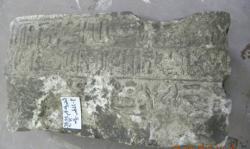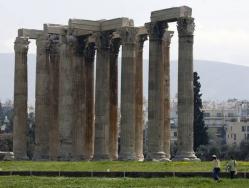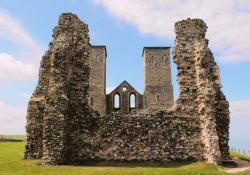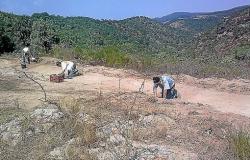INSTITUT SUPERIEUR D'ANTHROPOLOGIE
INSTITUTE OF ANTHROPOLOGY
ONLINE COURSES / COURS A DISTANCE
INSCRIPTION : Année Universitaire 2012/2013
REGISTRATION : Academic Year 2012 / 2013
EGYPTE –  Le Caire - An 18th dynasty stele inscribed with religious text was found in the debris from construction work in Matariya. Construction work by the Ministry of Endowments was carried out last week at the Al-Khamis market in the Matariya area in northern Cairo, in violation of laws relating to antiquities. A large section of the souq was dug to a depth of four metres in order to construct a stone wall, and the debris was left covering another piece of land. Although the land is in the possession of the Ministry of Endowments, it is under the supervision of the Ministry of State for Antiquities (MSA) as there may be undiscovered antiquities located in the area. Matariya was a renowned religious centre during the pharaonic era, as well as in Graeco-Roman and Coptic times, when it was known as Heliopolis. During his routine shift, the souq's security guard stumbled upon an 18th dynasty religious stele within the debris. Antiquities minister Mohamed Ibrahim stated that the stele is carved out of limestone and bears three lines of hieroglyphic text. The first line reveals the name of the purification priest at the temple of the God Re in ancient Heliopolis. The second and third lines have not yet been deciphered as the section has deteriorated somewhat, but the name of goddess Hathor can be read. The stele is currently being studied by experts at the Matariya archaeological lab.
Le Caire - An 18th dynasty stele inscribed with religious text was found in the debris from construction work in Matariya. Construction work by the Ministry of Endowments was carried out last week at the Al-Khamis market in the Matariya area in northern Cairo, in violation of laws relating to antiquities. A large section of the souq was dug to a depth of four metres in order to construct a stone wall, and the debris was left covering another piece of land. Although the land is in the possession of the Ministry of Endowments, it is under the supervision of the Ministry of State for Antiquities (MSA) as there may be undiscovered antiquities located in the area. Matariya was a renowned religious centre during the pharaonic era, as well as in Graeco-Roman and Coptic times, when it was known as Heliopolis. During his routine shift, the souq's security guard stumbled upon an 18th dynasty religious stele within the debris. Antiquities minister Mohamed Ibrahim stated that the stele is carved out of limestone and bears three lines of hieroglyphic text. The first line reveals the name of the purification priest at the temple of the God Re in ancient Heliopolis. The second and third lines have not yet been deciphered as the section has deteriorated somewhat, but the name of goddess Hathor can be read. The stele is currently being studied by experts at the Matariya archaeological lab.
http://english.ahram.org.eg/NewsContent/9/40/52528/Heritage/Ancient-Egypt/Building-blunder-prompts-discovery-of-pharaonic-st.aspx
ROYAUME UNI – Repton - Significant archaeological evidence has been uncovered that indicates a Derbyshire village could have attracted settlers as early as the third century. Until now, Repton's known history dates from 653AD, when it became the place where Christianity was first preached in the Midlands and a double abbey was established. But during excavations for a new science building for Repton School, ditches and pits dating from hundreds of years earlier were found. They formed a series of small enclosures and are believed to date from as far back as the third century. Myk Flitcroft, senior associate director of CgMS consulting, which managed the archaeological team, said: "The information gleaned from the site is important because it provides the first confirmed evidence for Roman and early Saxon activity and adds to the important later Saxon and Viking period history in the area. Mr Flitcroft said: "The ditches and pits didn't contain too much but they are located on the edge of a much larger original site and allow us to add some details to the story and history of Repton." The Romans ruled Britain from 43AD until about 410. In their place came the Saxons, who ruled for 600 years and who made Repton the capital of their Mercia kingdom. They were followed by the Vikings. Archaeological excavations took place in the village every year from 1974 to 1988. Among their discoveries were a stone chapel and Viking burial mound. Archaeologists were called in to observe the latest excavations on the site in Willington Road because of its location at the edge of the village's historic centre. They identified an area which warranted a more detailed dig.
http://www.thisisderbyshire.co.uk/Discovery-Roman-past-real-life-school-history/story-16902012-detail/story.html
GRECE –  They survived wars, plunderers, earthquakes, millions of tourists and nearly 2,000 years of time. But they may not survive Greece's debt crisis. The great ruins of ancient Greek civilization are being imperiled by massive budget cuts Greece is imposing to qualify for European bailout funds after years of overspending, say preservation experts. "Hadrian's Arch and the Temple of Olympian Zeus are in danger of falling down," said Despina Koutsoumba, head of the Association of Greek Archaeologists. The carved stone statues and structures that are out in the open and important to the country's tourism industry usually receive restoration work after every winter. However, Hadrian's Arch, a Roman triumphal gateway, and the Temple of Zeus, named for the greatest of the Greek gods, received no care this year because of budget cuts. They are among many examples of Greek culture that face possible erosion, Koutsoumba says. The Ministry of Culture's budget has been cut by 50% over the past two years, and deputy minister of culture Kostas Tzavaras says another 50% cut looms. But many here say that even if the cuts are a long time coming, they do not have to result in a reduction in care for Greece's architectural treasures.
They survived wars, plunderers, earthquakes, millions of tourists and nearly 2,000 years of time. But they may not survive Greece's debt crisis. The great ruins of ancient Greek civilization are being imperiled by massive budget cuts Greece is imposing to qualify for European bailout funds after years of overspending, say preservation experts. "Hadrian's Arch and the Temple of Olympian Zeus are in danger of falling down," said Despina Koutsoumba, head of the Association of Greek Archaeologists. The carved stone statues and structures that are out in the open and important to the country's tourism industry usually receive restoration work after every winter. However, Hadrian's Arch, a Roman triumphal gateway, and the Temple of Zeus, named for the greatest of the Greek gods, received no care this year because of budget cuts. They are among many examples of Greek culture that face possible erosion, Koutsoumba says. The Ministry of Culture's budget has been cut by 50% over the past two years, and deputy minister of culture Kostas Tzavaras says another 50% cut looms. But many here say that even if the cuts are a long time coming, they do not have to result in a reduction in care for Greece's architectural treasures.
http://www.livingstondaily.com/usatoday/article/57779798?odyssey=mod%7Cnewswell%7Ctext%7CFrontpage%7Cp
ROYAUME UNI –  Herne Bay - Herne Bay's Victorian history is well-documented – but the town's roots go back much further, according to local historian Geoff Wimble. Mr Wimble, who has recovered various Roman artefacts including brooches whilst out metal detecting, points to archaeological evidence to buttress his claim. He says there are clear signs that Herne Bay, and not just Reculver, was home to a Roman presence which has come to light in several archeological digs. Mr Stevens wrote: "The site is located in an area of Kent rich in known archaeological remains. A number of archaeological investigations have been undertaken in the general area in recent years. "A multi-phase site has been excavated to the west of the current site. Remains dating from the late Bronze Age / early Iron Age, Romano-British and Anglo-Saxon periods were encountered. "The results of further evaluation work suggest that this site is large in extent and straddles the current alignment of the A299. "Another evaluation uncovered evidence of Iron Age and medieval activity to the west, whilst archaeological investigations to the east of the current site have also uncovered evidence of prehistoric and medieval activity at Willow and at Bogshole Lane, Broomfield." It is the evidence of a Roman presence in the area that particularly interests Mr Wimble.
Herne Bay - Herne Bay's Victorian history is well-documented – but the town's roots go back much further, according to local historian Geoff Wimble. Mr Wimble, who has recovered various Roman artefacts including brooches whilst out metal detecting, points to archaeological evidence to buttress his claim. He says there are clear signs that Herne Bay, and not just Reculver, was home to a Roman presence which has come to light in several archeological digs. Mr Stevens wrote: "The site is located in an area of Kent rich in known archaeological remains. A number of archaeological investigations have been undertaken in the general area in recent years. "A multi-phase site has been excavated to the west of the current site. Remains dating from the late Bronze Age / early Iron Age, Romano-British and Anglo-Saxon periods were encountered. "The results of further evaluation work suggest that this site is large in extent and straddles the current alignment of the A299. "Another evaluation uncovered evidence of Iron Age and medieval activity to the west, whilst archaeological investigations to the east of the current site have also uncovered evidence of prehistoric and medieval activity at Willow and at Bogshole Lane, Broomfield." It is the evidence of a Roman presence in the area that particularly interests Mr Wimble.
http://www.thisiskent.co.uk/Did-Romans-settle-Herne-Bay/story-16892674-detail/story.html
FRANCE –  Le Perthus - Le conseil général a décidé la mise en place d'un projet de recherches archéologiques destiné à étudier la Via Domitia, notamment entre le Tech et les Pyrénées. Ainsi ont été programmées, de mai à novembre, un certain nombre de fouilles sur le tracé de la voie ou à proximité, en vue de mieux connaître l'identification de certains sites liés à son passage Après une première campagne de recherches autour de la Redoute du village (camp de la Torre), une autre série de fouilles se déroule sur le site archéologique de Panissars pour retrouver l'orientation de la Via Domitia en aval du Trophée de Pompée. Ces travaux suivis par la DRAC, le Pôle archéologique des P.-O. et Georges Castellvi, archéologue conseil, ont été confiés, après concours, à l'INRAP. C'est Jérôme Kotarba, ingénieur d'études, qui en a la charge. Au mas de Panissars, onze points de fouilles devraient permettre ainsi de localiser plus finement le tracé de la voie et l'histoire de la dégradation du tronçon juste avant l'accès au trophée de Pompée. La fouille dure jusqu'à lundi 17 septembre et reste un point d'intérêt pour les Perthusiens soucieux de leur patrimoine.
Le Perthus - Le conseil général a décidé la mise en place d'un projet de recherches archéologiques destiné à étudier la Via Domitia, notamment entre le Tech et les Pyrénées. Ainsi ont été programmées, de mai à novembre, un certain nombre de fouilles sur le tracé de la voie ou à proximité, en vue de mieux connaître l'identification de certains sites liés à son passage Après une première campagne de recherches autour de la Redoute du village (camp de la Torre), une autre série de fouilles se déroule sur le site archéologique de Panissars pour retrouver l'orientation de la Via Domitia en aval du Trophée de Pompée. Ces travaux suivis par la DRAC, le Pôle archéologique des P.-O. et Georges Castellvi, archéologue conseil, ont été confiés, après concours, à l'INRAP. C'est Jérôme Kotarba, ingénieur d'études, qui en a la charge. Au mas de Panissars, onze points de fouilles devraient permettre ainsi de localiser plus finement le tracé de la voie et l'histoire de la dégradation du tronçon juste avant l'accès au trophée de Pompée. La fouille dure jusqu'à lundi 17 septembre et reste un point d'intérêt pour les Perthusiens soucieux de leur patrimoine.
http://www.lindependant.fr/2012/09/14/des-fouilles-archeologiques-a-panissars,164627.php